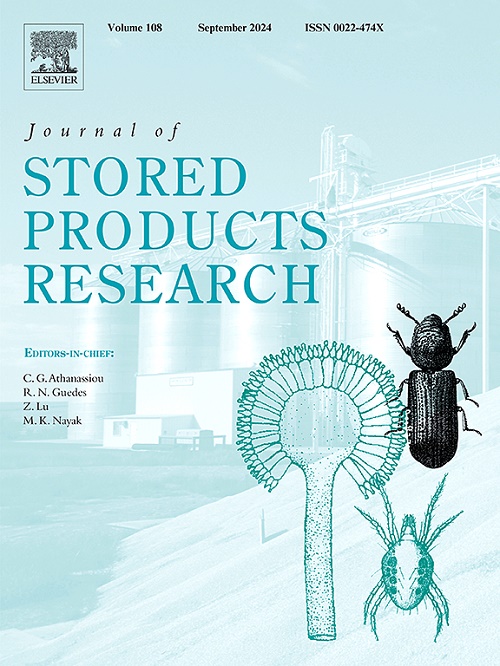“Effect of various storage techniques on the physical, nutritional, and sensory properties of sorghum in Tigray, Ethiopia”
IF 2.7
2区 农林科学
Q1 ENTOMOLOGY
引用次数: 0
Abstract
Sorghum, a crucial cereal crop for smallholder farmers in Ethiopia, serves as an essential source of food, income, and nutrition. The aim of this study was to evaluate the effects of five grain storage technologies: Purdue Improved Crop Storage (PICS) bags, ZeroFly bags, polypropylene bags, filter-cake-treated polypropylene bags, and underground pits on the physicochemical properties of sorghum grains and the sensory quality of injera prepared from stored grain. Using proximate composition analysis as per the Association of Official Analytical Chemists (AACC) standards, the results showed that after six months of storage, PICS bags preserved the highest germination energy (87.83%), whereas underground pits had the lowest (39.79%). PICS bags were the only technology maintaining germination viability above 85%. Moisture content increased across all storage technologies, with the most significant rise observed in underground pits (11.42%–17.48%). Nutrient losses, including reductions in protein, fiber, ash, and fat, were more pronounced in grains stored in filter-cake-treated bags, ZeroFly bags, polypropylene bags, and underground pits. However, minimum loss was recorded in the PICS bag. Sensory analysis demonstrated that injera made from sorghum stored in PICS bags received the highest preference scores. The findings highlight that PICS bags effectively preserve the physical, nutritional, and sensory quality of sorghum grains while mitigating storage losses. Consequently, PICS bags are recommended as a sustainable and eco-friendly solution for improving postharvest grain management in diverse agro-ecological settings in Tigray, Ethiopia.
求助全文
约1分钟内获得全文
求助全文
来源期刊
CiteScore
5.70
自引率
18.50%
发文量
112
审稿时长
45 days
期刊介绍:
The Journal of Stored Products Research provides an international medium for the publication of both reviews and original results from laboratory and field studies on the preservation and safety of stored products, notably food stocks, covering storage-related problems from the producer through the supply chain to the consumer. Stored products are characterised by having relatively low moisture content and include raw and semi-processed foods, animal feedstuffs, and a range of other durable items, including materials such as clothing or museum artefacts.

 求助内容:
求助内容: 应助结果提醒方式:
应助结果提醒方式:


